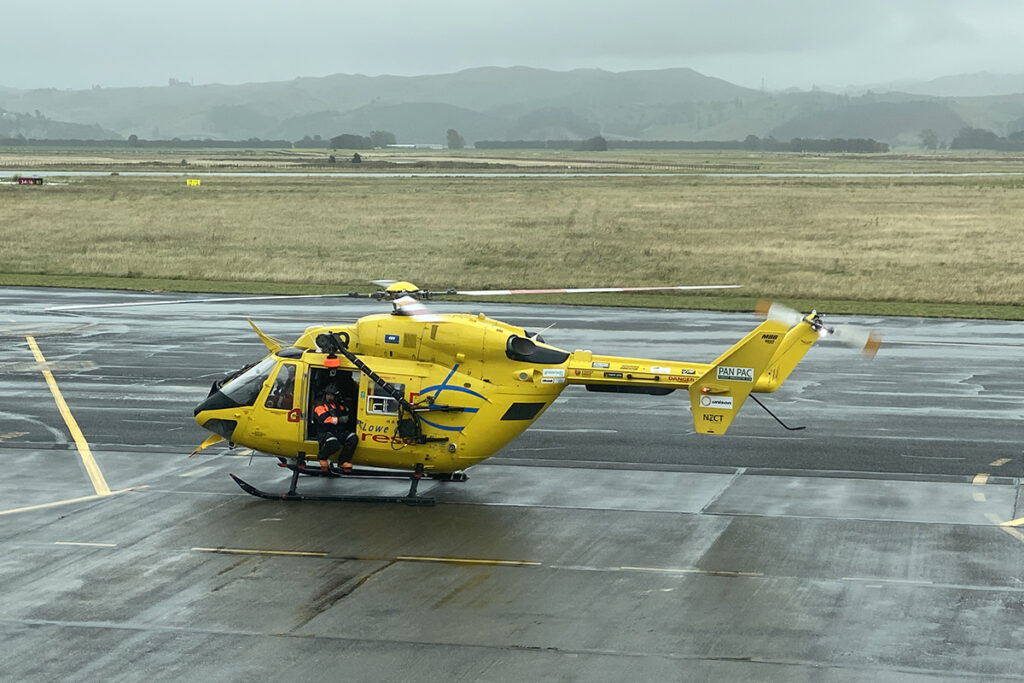[As published in March/April BayBuzz magazine.]
Providing vital connections to the rest of the country and the world is BAU for Napier Port and Hawke’s Bay Airport. But Cyclone Gabrielle saw our sea and air ports step up to support first responders. Napier Port has come through the cyclone remarkably well, says CEO Todd Dawson. “Which means we have been able to restart shipping. It’s also enabled us to support others providing critical services as well, such as the defence force.”
Cyclone Gabrielle has had minimal physical impact on the port. As a precaution port operations were suspended at 5:00pm Monday 13 February, and berthed vessels went out to sea to ride out the storm in relative safety. Generators kicked in supplying electricity, police and the defence force moved in, and Royal NZ Navy ships berthed as resources mobilised.
“The port’s main role in regional recovery is to get the port up and running,” says Dawson. “The best thing Napier Port can do is keep essential supplies and imports coming into the region, and to help exporters get their cargo to market.
“Cargo owners have been in touch every day wanting to know how soon they can get their products on to vessels, so it is really rewarding for the whole team who have been working hard to make this happen.
“Across the region we have been pitching in where we could offer the best help and many of the port team were volunteering in different roles.”
Dawson says that the port is wrapping support and care around its people. “Some have lost a lot. Our welfare team is a group of people from all areas of the port and they are on the ground every day checking in and seeing who needs help and how we can provide that.”
Full power was restored the afternoon of Monday 20 February, and the process of restarting full port operations began.
As for the impact on trade volumes and port financials, Dawson says it’s clear that the storm will impact trade volumes particularly in the fresh produce sectors.
“We’ll keep the market updated as we gain greater visibility on the outlook for regional seaborne trade. As of Wednesday 22 February we can’t quantify the impact on regional business and the trade across Napier Port’s wharves.
“While we know there is devastation, there are also harvests, crops, wood products and other cargoes that producers are needing to export.”
Dawson says that in the six years since he moved his family to Hawke’s Bay he’s learned that people and businesses are tough.
“Maybe it’s a primary sector attitude of overcoming problems and finding solutions. People dig in and look out for each other; and the world still wants a lot of what our region produces.
“It’s important that people are looked after first and foremost, and then it’s about regional recovery. We need to support businesses to open and get back into trading, because that will support jobs and the regional economy, and jobs support families and communities to get back up,” Dawson concludes.
HB Airport
Across the way at Westshore, Hawke’s Bay Airport (HBA) has been another critical lifeline into and out of Hawke’s Bay in the wake of Gabrielle, especially for the immediate emergency response effort.
“As a key regional transport asset, we provide crucial access for the emergency management resources that come to support our communities in times of need. With Cyclone Gabrielle’s impact on our roading networks, the airport gateway has been essential for getting help to our communities, especially the more remote ones,” says Hawke’s Bay Airport CEO Rob Stratford.
The airport prepared well for the cyclone’s arrival with its dewatering programme activated to lower the airside water table in anticipation of heavy rain. All light aircraft were hangered or tied down and all Air New Zealand aircraft that would normally overnight were flown elsewhere as a safety measure.
The airport has been fully operational throughout Gabrielle and in subsequent days and has provided a critical gateway for the regional emergency response effort, says Stratford.
“When power was lost early on Tuesday 14 February, generators allowed the airport and air traffic control to continue to operate, and critical support services like the NZ Defence Force had immediate air access from day one of the emergency response.”
The main runway was not impacted by the cyclone, and Stratford says the airport sustained only minimal damage.
“There was minor flooding on the secondary apron and ring road; both were cleared quickly.

“We were able to ensure the many helicopters – civilian and NZDF – had sufficient fuel for round-the-clock rescue operations, and within the terminal we supported those rescued and brought to the airport with meals and somewhere to rest.
“For our community within reach of the airport, we opened the terminal to them so they could charge personal devices and connect with family and friends over the free Wi-Fi. Carpark barrier arms were lifted during this time so that no one incurred any parking charges.
“Our busiest day was Wednesday, the day after the cyclone when 1,600 people visited the terminal. At one point we had 600 people connecting to the Wi-Fi at once.”
Full power was restored on Monday 20 February, which further enabled helicopters and fixed wing aircraft to be appropriately maintained during the recovery phase.
